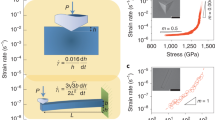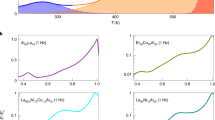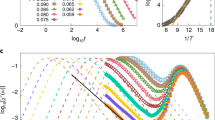Abstract
A wide variety of materials ranging from metals to polymers can solidify as glasses rather than crystals. The glass transition is associated with a slowing down of molecular motion: a liquid becomes a glass when structural relaxation no longer occurs on experimentally accessible timescales. Most of our current knowledge about collective molecular motion in glass-forming materials is based on observations of the supercooled liquid state above the glass transition1,2. The lack of direct information about molecular dynamics in the glass state itself leaves room for conflicting models of the glass transition2–9. Here we show that, by taking advantage of confinement effects in thin films, molecular dynamics can also be probed experimentally below the glass transition. We use second-harmonic generation to study the relaxation behaviour of molecules of a glass-forming liquid crystal confined in a thin film on a silica plate. Our measurements provide direct evidence that the collective character of molecular motion is responsible for the slowing down of mobility in glasses.
This is a preview of subscription content, access via your institution
Access options
Subscribe to this journal
Receive 51 print issues and online access
$199.00 per year
only $3.90 per issue
Buy this article
- Purchase on Springer Link
- Instant access to full article PDF
Prices may be subject to local taxes which are calculated during checkout
Similar content being viewed by others
References
Angell, C. A. Relaxation in liquids, polymers and plastic crystal-strong/fragile patterns and related problems. J. Non-Cryst. Solids 131–133, 13–31 (1991).
Jäckle, J. Models of the glass transition. Rep. Prog. Phys. 49, 171–231 (1986).
Angell, C. A. Perspective on the glass transition. J. Phys. Chem. Solids 49, 863–871 (1988).
Hansen, J. P. Clarifying the kinetic glass transition. Phys. World 4 (12), 32–36 (1991).
Götze, W., Sjögren, L. Relaxation process in supercooled liquids. Rep. Prog. Phys. 55, 241–376 (1992).
Kivelson, D., Tarjus, G., Zhao, X. & Kivelson, S. A. Fitting of viscosity: distinguishing the temperature dependences predicted by various models of supercooled liquids. Phys. Rev. E 53, 751–758 (1996).
Kirkpatrick, T. R., Thirumalai, D. & Wolynes, P. G. Scaling concepts for the dynamics of viscous liquids near an ideal glassy state. Phys. Rev. A 40, 1045–1054 (1989).
Sethna, J. P., Shore, J. D. & Huang, M. Scaling theory for the glass transition. Phys. Rev. B 44, 4943–4959 (1991).
Brüning, R. & Samwer, K. Glass transition on long time scales. Phys. Rev. B. 46, 11318–11322 (1992).
Jäckle, J. Thermoviscoelastic theory of freezing of stress and strain in a symmetrically cooled infinite glass plate. J. Non-Cryst. Solids 172–174, 104–107 (1994).
Cicerone, M. T., Blackburn, F. R. & Ediger, M. D. How do molecules move near Tg? Molecular rotation of six probes in o-terphenyl across 14 decades in time. J. Chem. Phys. 102, 471–479 (1995).
Kivelson, D., Kivelson, S. A., Zhao, X., Nussinov, Z. & Targus, G. A thermodynamic theory of supercooled liquids. Physica A 219, 27–38 (1995).
Jenckel, E. Zur Temperaturabhängigkeit der Viscosität van Schmeizen. Z. Phys. Chem. 184, 309–319 (1939).
McLaughlin, E. & Ubbelohde, A. R. Structure and viscosity of melts of aromatic hydrocarbons. Trans. Faraday Soc. 54, 1804–1810 (1958).
Adam, G. & Gibbs, J. H. On the temperature dependence of cooperative relaxation properties in glass-forming liquids. J. Chem. Phys. 43, 139–146 (1965).
Fisher, E. W., Donth, E. & Steffen, W. Temperature dependence of characteristic length for glass transition. Phys. Rev. Lett. 68, 2344–2346 (1992).
Kondo, T. & Tsumuraya, K. Isosahedral clustering in a supercooled liquid and glass. J. Chem. Phys. 94, 8220–8226 (1991).
Mansfield, K. F. & Theordorou, D. N. Molecular dynamics simulation of a glassy polymer surface. Macromolecules 24, 6283–6294 (1991).
Ray, P. & Binder, K. Finite-size effect in the dynamics near the glass transition. Europhys. Lett. 27, 53–58 (1994).
Ernst, R. M., Nagel, S. R. & Grest, G. S. Search for a correlation length in a simulation of the glass transition. Phys. Rev. B 43, 8070–8080 (1991).
Jackson, C. L. & McKenna, G. B. The glass transition of organic liquids confined to small pores. J. Non-Cryst. Solids 131–133, 221–224 (1991).
Zhang, J., Liu, G. & Jonas, J. Effects of confinement on the glass transition temperature of molecular liquids. J. Phys. Chem. 96, 3478–3480 (1992).
Reiter, G. Mobility of polymers in films thinner than their unperturbed size. Europhys. Lett. 23, 579–584 (1993).
Keddie, J. L., Jones, R. A. L. & Cory, R. A. Size-dependent depression of the glass transition temperature in polymer films. Europhys. Lett. 27, 59–64 (1994); Interface and surface effects on the glass-transition temperature in thin polymer films. Faraday Discuss. 98, 219–230 (1994).
Forrest, J. A., Dalnoki-Veress, K., Stevens, J. R. & Dutcher, J. R. Effect of free surfaces on the glass transition temperature of thin polymer films. Phys. Rev. Lett. 77, 2002–2005 (1996).
Schüller, J., Mel'nichenko, Yu. B., Richert, R. & Fischer, E. W. Dielectric studies of the glass transition in porous media. Phys. Rev. Lett. 73, 2224–2227 (1994).
Guyot-Sionnest, P., Hsiung, H. & Shen, Y. R. Surface polar ordering in a liquid crystal observed by optical second-harmonic generation. Phys. Rev. Lett. 57, 2963–2966 (1986).
Jérôme, B., O'Brien, J., Ouchi, Y., Stanners, C. & Shen, Y. R. Bulk reorientation driven by orientational transitin in a liquid crystal monolayer. Phys. Rev. Lett. 71, 758–761 (1993).
de Wit, P. P., Erdhuisen, E. W. P. & Picken, S. J. patent WO 96/03476.
Author information
Authors and Affiliations
Rights and permissions
About this article
Cite this article
Jérôme, B., Commandeur, J. Dynamics of glasses below the glass transition. Nature 386, 589–592 (1997). https://doi.org/10.1038/386589a0
Received:
Accepted:
Issue Date:
DOI: https://doi.org/10.1038/386589a0
This article is cited by
-
A New Phenomenon: Sub-Tg, Solid-State, Plasticity-Induced Bonding in Polymers
Scientific Reports (2017)
-
Structural aspects of deformation of amorphous polymers
Russian Chemical Bulletin (2005)
-
Growing range of correlated motion in a polymer melt on cooling towards the glass transition
Nature (1999)
Comments
By submitting a comment you agree to abide by our Terms and Community Guidelines. If you find something abusive or that does not comply with our terms or guidelines please flag it as inappropriate.



